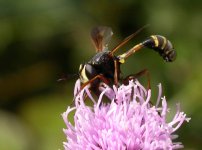I'd appreciate any help that anyone might be able to offer in identifying the attached wasp (at least I think it's a wasp). I shot it today on some thistle heads in Middlesex - It didn't seem to be hunting or parasitising anything, so no clues there. Thanks in advance.
-
Welcome to BirdForum, the internet's largest birding community with thousands of members from all over the world. The forums are dedicated to wild birds, birding, binoculars and equipment and all that goes with it.
Please register for an account to take part in the discussions in the forum, post your pictures in the gallery and more.
Please help with wasp ID (1 Viewer)
- Thread starter herring
- Start date




